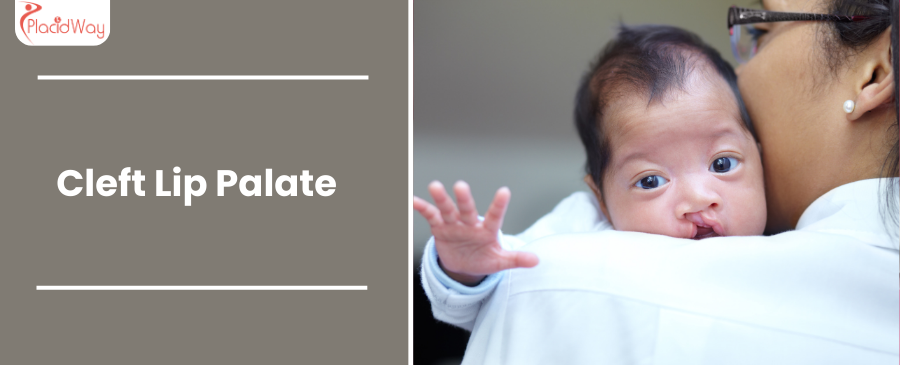
Navigating Cleft Lip and Palate: Understanding Treatment & Exploring Global Options
Discovering that a child has a cleft lip or palate can be an emotional experience for any parent. These common birth defects, which occur when facial structures don't fully fuse during early pregnancy, can affect not only appearance but also critical functions like feeding, speech, and hearing. While the journey ahead might seem daunting, it's important to remember that highly effective surgical treatments are available, offering incredible transformations and a path to a fulfilling life.
For many, accessing the best care involves exploring options beyond their home country. Medical tourism for cleft lip and palate surgery has become a viable and often preferable route for families seeking specialized expertise, reduced waiting times, or more affordable treatment costs without compromising on quality. This comprehensive guide will walk you through everything you need to know, from understanding the condition itself to navigating the world of international medical care, helping you make informed decisions for your loved one's future.
What is Cleft Lip and Cleft Palate?
A cleft lip is a physical split or separation of the two sides of the upper lip, appearing as a narrow opening or gap. It can range from a slight notch in the lip to a complete separation extending into the nose. A cleft palate, on the other hand, is an opening or split in the roof of the mouth, which can affect the hard palate (bony front part) or the soft palate (fleshy back part), or both. These conditions occur when the tissues that form the lip and/or palate do not join completely during the early stages of fetal development.
Both conditions can occur together or independently. While they are immediately noticeable at birth, their impact extends beyond aesthetics, affecting feeding, speech development, hearing, and dental health. Early diagnosis and a multi-disciplinary approach to treatment, centered around surgical repair, are crucial for optimal outcomes.
Recognizing the Signs: Symptoms of Cleft Lip and Palate
Cleft lip and palate are typically diagnosed at birth, often during routine prenatal ultrasounds. However, their symptoms can manifest in various ways, impacting a child's development. Here's what to look for:
- Visible Opening: The most obvious sign is a clear split in the lip (unilateral or bilateral) or an opening in the roof of the mouth.
- Feeding Difficulties: Infants with cleft palate may struggle to create suction, leading to challenges with breastfeeding or bottle-feeding, nasal regurgitation (milk coming out through the nose), and slower weight gain.
- Speech Problems: As the child grows, a cleft palate can hinder proper speech development, leading to hypernasal speech (a voice that sounds like air is escaping through the nose) or difficulty forming certain sounds.
- Ear Infections and Hearing Loss: The opening in the palate can affect the Eustachian tubes, leading to fluid buildup in the middle ear and recurrent ear infections, potentially causing temporary or permanent hearing loss.
- Dental Issues: Children with cleft conditions may experience missing teeth, malformed teeth, or misalignment of the upper jaw and teeth.
- Nasal Deformity: A cleft lip often comes with an associated deformity of the nose, affecting its shape and symmetry.
Early identification of these symptoms allows for timely intervention and the development of a comprehensive treatment plan.
Understanding the Roots: Causes and Risk Factors of Cleft Conditions
While the precise cause of cleft lip and palate is often unknown, research points to a combination of genetic and environmental factors:
- Genetics: A family history of cleft lip or palate significantly increases the risk. Genes passed down from parents can make a child more susceptible to developing the condition.
- Environmental Factors:
- Maternal Smoking and Alcohol Use: Women who smoke or consume alcohol during pregnancy have a higher risk of having a baby with a cleft condition.
- Certain Medications: Some medications, particularly those taken during early pregnancy (e.g., anti-seizure drugs, steroids, or acne medications containing isotretinoin), have been linked to an increased risk.
- Lack of Folic Acid: Inadequate folic acid intake during pregnancy is a known risk factor for various birth defects, including cleft conditions.
- Maternal Diabetes: Women diagnosed with diabetes before pregnancy may have a slightly higher risk of having a baby with a cleft lip with or without cleft palate.
- Obesity During Pregnancy: Maternal obesity has also been identified as a potential risk factor.
It's important to note that in many cases, children with cleft conditions are born to parents with no known risk factors. Understanding these potential influences helps in genetic counseling and preventative measures where possible.
Tailored Solutions: Types of Cleft Lip and Palate Procedures
The treatment for cleft lip and palate is a multi-stage process, often involving several surgical procedures and ongoing care from a multidisciplinary team. The primary goal of surgery is to close the openings, restore normal function, and improve appearance. Common procedures include:
- Cleft Lip Repair (Cheiloplasty): Typically performed when the baby is around 3-6 months old. This surgery closes the gap in the lip, reforms the natural shape of the lip, and reconstructs the philtrum (the vertical groove in the middle of the upper lip). It also helps to improve nose symmetry.
- Cleft Palate Repair (Palatoplasty): Usually done when the baby is 9-18 months old. This surgery closes the opening in the roof of the mouth, separating the oral and nasal cavities. It's crucial for normal feeding, speech development, and preventing ear infections.
- Secondary Surgeries: As the child grows, additional procedures may be necessary:
- Alveolar Bone Graft: To fill the gap in the upper gum line, usually around 8-12 years old, allowing permanent teeth to erupt properly.
- Speech Surgery (Pharyngoplasty/Furlow Palatoplasty): If speech problems persist after initial palate repair, these surgeries can improve velopharyngeal function (the ability to close off the nose from the mouth during speech).
- Rhinoplasty: To improve nasal symmetry and shape, often performed in adolescence.
- Orthognathic Surgery (Jaw Surgery): In some cases, to correct significant jaw misalignment that can affect biting and chewing, typically in late adolescence.
The exact timing and sequence of surgeries depend on the individual child's condition and development.
Who is a Candidate? Eligibility for Cleft Lip and Palate Surgery
Eligibility for cleft lip and palate surgery is primarily determined by the patient's age, weight, and overall health status. While the goal is to perform surgeries at optimal developmental stages, the child's well-being is paramount. General guidelines include:
- Age:
- Cleft Lip Repair: Typically performed between 3 to 6 months of age. At this stage, the baby has grown sufficiently and the facial structures are more developed, making the surgery safer and the results more refined.
- Cleft Palate Repair: Usually performed between 9 to 18 months of age, before the child begins to develop speech patterns. This timing helps facilitate normal speech development and reduces the risk of long-term speech issues.
- Weight: Infants usually need to reach a certain weight (e.g., 10 pounds or more) to ensure they can tolerate anesthesia and recover well from surgery.
- General Health: The child must be in good health, free from acute infections (like colds or flu), and have no major underlying medical conditions that would contraindicate surgery.
- Anesthesiology Clearance: A thorough evaluation by an anesthesiologist is required to ensure the child can safely undergo general anesthesia.
For secondary procedures, eligibility depends on the specific need and the child's growth and development, often waiting until later childhood or adolescence.
The Journey to Recovery: What to Expect Post-Surgery
Recovery is a critical phase following cleft lip and palate surgery, requiring diligent care to ensure optimal healing and outcomes. Here's what families can typically expect:
- Hospital Stay: Usually 1-3 days, depending on the type of surgery and the child's recovery.
- Pain Management: Pain medication will be prescribed to keep the child comfortable. Swelling and bruising are normal.
- Wound Care:
- Cleft Lip: The incision will have stitches, possibly covered with a dissolvable dressing or tape. Keeping the incision clean and moist with antibiotic ointment (if advised) is crucial. "Arm restraints" or "no-no" splints are often used to prevent the baby from touching the incision.
- Cleft Palate: The palate incision requires careful attention to diet. Oral rinses may be prescribed.
- Feeding:
- Cleft Lip: Babies can usually resume their normal feeding method (breast or bottle) soon after surgery, with adaptations as advised by the medical team.
- Cleft Palate: A soft, puréed diet is essential for several weeks to protect the healing palate. Special cups or syringes may be used to avoid spoons or straws that could damage the surgical site.
- Activity Restrictions: Strenuous activities, objects in the mouth, and hard foods are restricted for a period to prevent injury to the surgical site.
- Follow-up Appointments: Regular check-ups with the surgeon and the cleft team are vital to monitor healing, speech development, dental health, and hearing.
Full healing for lip repair usually takes a few weeks for initial recovery, while palate repair takes longer, with internal healing continuing for several months. Scarring will fade over time but will be permanent.
Navigating the Possibilities: Risks and Side Effects of Cleft Surgery
As with any surgical procedure, cleft lip and palate repair carry potential risks and side effects, though serious complications are rare. It's important to discuss these thoroughly with your surgical team:
- General Surgical Risks:
- Infection: Though antibiotics are often given, infection at the surgical site can occur.
- Bleeding: Some bleeding is normal, but excessive bleeding can be a complication.
- Anesthesia Complications: Reactions to anesthesia, though rare in healthy infants, are a potential risk.
- Scarring: While surgeons strive for minimal scarring, a scar will remain. Its appearance can vary.
- Specific Risks for Cleft Lip Repair:
- Asymmetry: Despite best efforts, slight asymmetry of the lip or nose may remain or develop over time, potentially requiring further revision.
- Scar Contraction: The scar tissue can contract over time, altering the lip's shape.
- Specific Risks for Cleft Palate Repair:
- Fistula Formation: A small hole (fistula) may reopen in the palate, requiring further surgery. This is one of the more common complications.
- Speech Problems: While palate repair significantly aids speech, some children may still develop hypernasal speech or require speech therapy or additional surgery (e.g., pharyngoplasty) later.
- Dental/Jaw Issues: Despite surgery, orthodontic treatment or further jaw surgery may be needed later in life.
Your medical team will take every precaution to minimize these risks and ensure the safest possible outcome for your child.
Worldwide Cost Comparison for Cleft Lip and Palate Surgery
The cost of cleft lip and palate surgery is a major consideration for many families. Prices can vary dramatically depending on the country, the clinic's reputation, the surgeon's experience, the complexity of the specific procedure(s), and whether the cost includes pre-operative assessments, hospital stay, anesthesia, and post-operative care. Medical tourism offers a compelling solution for many due to these price discrepancies.
| Country | Estimated Cleft Lip Repair Cost (USD) | Estimated Cleft Palate Repair Cost (USD) | Notes |
|---|---|---|---|
| USA / Canada | $15,000 - $40,000+ | $20,000 - $50,000+ | High costs, but excellent standard of care. Insurance often covers a portion. |
| UK / Western Europe | $10,000 - $25,000 | $15,000 - $35,000 | Similar high standards, often covered by public healthcare, but private costs are significant. |
| Mexico | $3,000 - $8,000 | $4,000 - $10,000 | Popular for US patients due to proximity and significant savings. |
| India | $2,500 - $7,000 | $3,500 - $9,000 | Known for highly skilled surgeons and state-of-the-art facilities at much lower costs. |
| Turkey | $4,000 - $9,000 | $5,000 - $12,000 | Emerging medical tourism hub with modern clinics and experienced surgeons. |
| Thailand | $3,500 - $8,500 | $4,500 - $11,000 | Excellent patient care and hospitality combined with competitive pricing. |
*Prices are estimates and can vary based on the clinic, surgeon's fees, scope of package, and individual patient needs. It's essential to get a personalized quote.
Why Consider Cleft Lip and Palate Surgery Abroad?
For many families, seeking cleft lip and palate surgery abroad presents several compelling advantages:
- Significant Cost Savings: As seen in the table above, the cost of procedures in countries like India, Mexico, or Turkey can be a fraction of those in the US, Canada, or Western Europe. This makes life-changing surgery accessible to more families.
- Access to Expert Surgeons and Advanced Facilities: Many international hospitals specialize in cleft care, boasting highly experienced plastic and reconstructive surgeons, pediatric anesthesiologists, and state-of-the-art equipment.
- Reduced Waiting Times: In countries with universal healthcare systems, waiting lists for non-emergency procedures can be lengthy. Traveling abroad often means quicker access to treatment.
- Comprehensive Care Packages: Many medical tourism providers offer all-inclusive packages that cover not only the surgery but also accommodation, transport, interpreter services, and post-operative care, simplifying the logistical burden.
- Privacy and Anonymity: Some families prefer the privacy that comes with receiving medical treatment in a different country.
- Combined with a Family Trip: For some, the journey can also be an opportunity to experience a new culture, turning a challenging medical trip into a more holistic experience.
Top Destinations: Which Countries Offer the Best Value for Cleft Care?
Several countries have established themselves as premier destinations for medical tourism, particularly for complex procedures like cleft lip and palate repair:
- India: Renowned for its JCI-accredited hospitals, highly skilled surgeons trained internationally, and extremely competitive pricing. India has dedicated cleft care centers that perform thousands of surgeries annually.
- Mexico: A popular choice for patients from the US and Canada due to its geographical proximity, offering excellent private hospitals, often with US-board certified surgeons, at significantly lower costs.
- Turkey: An emerging hub for medical tourism, Turkey boasts modern hospitals with cutting-edge technology, experienced plastic surgeons, and comprehensive care packages, particularly in cities like Istanbul.
- Thailand: Known for its exceptional patient care, world-class private hospitals, and highly trained medical professionals, offering a blend of quality healthcare and renowned hospitality.
- South Korea: While potentially a higher price point than some Asian counterparts, South Korea is a leader in plastic and reconstructive surgery, offering advanced techniques and excellent outcomes, particularly for aesthetic revisions.
When selecting a destination, consider not just cost, but also the reputation of specific hospitals and surgeons, language barriers, visa requirements, and the support services available for medical tourists.
Planning Your Journey: What to Expect When Traveling for Cleft Surgery Abroad?
Embarking on a medical journey abroad requires careful planning. Here’s a general overview of what to expect:
- Research and Consultation: Begin by researching potential clinics and surgeons. PlacidWay can help you connect with reputable providers, compare quotes, and arrange initial virtual consultations to discuss the treatment plan, costs, and logistics.
- Medical Records and Evaluation: You'll need to send your child's medical records, photos, and any relevant test results for the foreign medical team to review. They will confirm eligibility and tailor a treatment plan.
- Travel Logistics: Arrange flights, accommodation (often near the hospital for convenience), and local transportation. Many medical tourism agencies offer assistance with these arrangements.
- Visa and Documentation: Check visa requirements for your destination country for both yourself and your child. Ensure all necessary travel documents (passports, birth certificates) are up-to-date.
- Pre-Operative Care: Upon arrival, expect thorough pre-operative assessments, blood tests, and consultations with the surgeon and anesthesiologist to ensure your child is ready for surgery.
- Surgery and Hospital Stay: The procedure will be performed, followed by a hospital stay for monitoring and initial recovery.
- Post-Operative Recovery and Follow-up: You will likely need to stay in the destination country for a period after discharge for follow-up appointments and to ensure stable recovery before flying home. The medical team will provide detailed post-operative care instructions.
- Communication: Language barriers can be a concern. Many international clinics have English-speaking staff or offer interpreter services.
PlacidWay specializes in streamlining this process, offering guidance and support every step of the way, making your medical travel experience as smooth and stress-free as possible.
Ensuring Excellence: How to Vet Safety and Quality of Cleft Care Abroad?
Ensuring the safety and quality of medical care abroad is paramount. Here's how you can vet potential providers:
- Accreditation: Look for international accreditations such as Joint Commission International (JCI). This signifies that the hospital meets rigorous international standards for patient safety and quality of care.
- Surgeon Credentials and Experience: Research the surgeon's qualifications, training, and experience specifically in cleft lip and palate surgery. Look for board certifications, professional affiliations (e.g., with international plastic surgery societies), and a high volume of successful cleft procedures.
- Facility Standards: Inquire about the hospital's facilities, including operating room technology, intensive care units (ICUs) for pediatric patients, and overall hygiene standards. Photos and virtual tours can be helpful.
- Multidisciplinary Team: Effective cleft care requires a team approach, including plastic surgeons, oral and maxillofacial surgeons, ENT specialists, speech therapists, orthodontists, and pediatricians. Ensure the clinic offers this comprehensive support.
- Patient Testimonials and Reviews: Seek out reviews and success stories from previous international patients. Organizations like PlacidWay can provide access to verified patient feedback.
- Communication and Transparency: A reputable provider will be transparent about costs, treatment plans, potential risks, and post-operative care. Clear communication in a language you understand is crucial.
- Post-Operative Support: Understand what kind of follow-up care is provided after you return home. Some clinics offer remote consultations or coordinate with local healthcare providers.
By diligently checking these aspects, you can significantly increase the chances of a safe and successful medical journey for your child.
Take the Next Step with PlacidWay
Ready to explore treatment options abroad? Discover top clinics, compare prices, and get a free quote tailored to your needs with PlacidWay.
Anti-aging | A world-renowned Antiaging facility





.jpg)
.png)
.png)
.jpg)

Share this listing